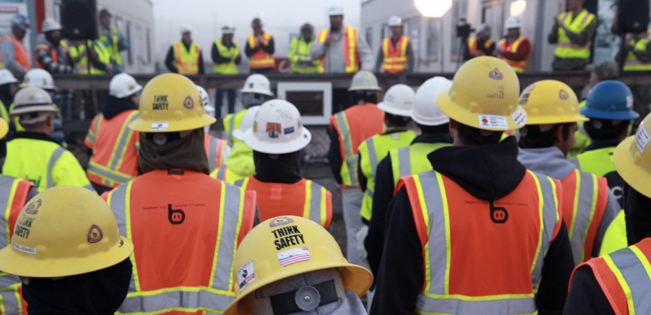If your job involves working in potentially hazardous areas that weren’t intended for human occupancy, then you need to sign up for a confined space entry training course. In Part 5 of our Fundamental Guide to Confined Space Entry Training, we will review all that has been previously outlined: relevant rules and regulations, exactly who needs this training, what you learn, and why confined space entry training matters so much. When it comes time for you to register, trust the experienced professionals at ACUTE Environmental and Safety Services to help keep you safe on the job. Contact us or sign up for our confined space entry training today.
Confined Space Entry Training – Fundamental Guide: Part 5
Why You Need To Know Reg. 632/05
Everything you need to know about confined spaces in Ontario comes from Ontario Regulation 632/05, which you can download here.
If you’re not sure what is meant by “confined space,” the above regulation defines it as a fully or partially enclosed space,
(a) that is not both designed and constructed for continuous human occupancy, and
(b) in which atmospheric hazards may occur because of its construction, location, contents, or because of work that is done in it.
Examples of spaces that are not designed and constructed for continuous human occupancy include tanks, vessels, silos, storage bins, hoppers, vaults, pits, manholes, tunnels, equipment housings, ductwork, and pipelines.

You must learn about confined spaces and the hazards involved.
Do You Need This Course?
Before diving into this work, you must be able to determine whether a space is indeed confined, recognize the dangers of various atmospheric hazards, and – most important – have the know-how to stay safe amid it all. According to the Ontario Ministry of Labour, Immigration, Training and Skills Development, “every worker who works in a confined space must receive adequate training in the recognition of hazards associated with confined spaces and training to be able to safely perform the assigned duties for that specific confined space.”
Training also is required if you will be contributing to the work activity – attendants and rescue workers, for example.

Click here to learn more about Confined Space Rescue Training.
What You Learn in Confined Space Entry Training
Confined spaces are considered high-risk work areas, and workers and would-be rescuers have been killed on the job in the past.
Due to the dangerous nature this work, there are very specific rules you need to follow when you work in and around these spaces. Using ACUTE’s training program as an example, the confined space entry training begins by familiarizing you with Regulation 632/05 . The training program is further intended to provide entrants, attendants, and competent persons the skills and training required to recognize confined space entry risks and how to establish measured and corresponding responses to them.
Finally, you will have the opportunity to become familiar with, inspect, and use Confined Space Entry (CSE) access equipment and air quality instrumentation.
To achieve that balance of classroom learning and in-the-field action, your confined space entry training should be conducted at an appropriate safety training center that offers the following:
- Industry standard health and safety equipment and technologies
- Simulation areas for a full suite of training programs (i.e. working at heights, confined spaces, and hazardous materials)
- Classroom facilities for lecture and technical training delivery
- Human dummies for confined space rescue and hazardous material controls.
That’s exactly what ACUTE’s training course offers – check our calendar to pick a date that works best for you. Be sure to set aside a full day for the course.

Confined space entry training should be conducted at a safety training center.
Why Confined Space Entry Training Matters To You
Working in confined spaces is a very serious endeavor. The risks associated with confined spaces are plentiful and potentially deadly. Oxygen deficiency/enrichment, toxicity, and free-flowing solids or liquids are just some of dangers that pose very real threats when working in confined spaces.
A more detailed outline of confined space dangers can be found in our article on the science behind the hazards of confined spaces, but here’s an example of the oxygen risks.
Entry awareness training will teach you more about these potential hazards, how to handle them, and this basic rule of thumb:
If you can’t test,
If you can’t ventilate,
If you don’t have a breathing apparatus,
If you don’t have an entry procedure,
Don’t go in!
For more, be sure to read our article on 5 habits of safe confined space workers.
Why You Should Trust ACUTE for Confined Space Entry Training?
Hands-on, practical confined space training is the best way to keep employers and workers safe in the workplace! ACUTE is dedicated to workplace safety and understands the importance of course and training provider approval. Why get workplace safety training with ACUTE? Here are just some of the benefits of working with ACUTE.

- Open Door Instructor-Student Partnership – ACUTE’s training services emphasize client participation. Staff foster relationships with clients and serve as a touchstone for advice anytime moving forward.
- Serving Your Team and Industry – With a vast array of clients in manufacturing, construction, health, academic, and government sectors, ACUTE brings the best safety practices from across the spectrum to your workplace.
- 100 Years Combined Experience – ACUTE provides comprehensive health and safety training, on-site safety services, and consulting services. With over 100 years of combined experience, our company staff offer more than theoretical or abstract ideas. ACUTE offers solutions.
- Track Record of Success – ACUTE is rated 4.9/5 stars on Google reviews, demonstrating a commitment to our clients, quality, and passion for training.
ACUTE is located in Waterloo, Ontario, and services customers from cities such as Toronto, Mississauga, Brampton, Hamilton, Milton, Kitchener, London, Guelph, and others across Ontario. Trust ACUTE for your confined space entry training needs.



